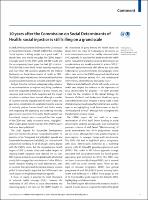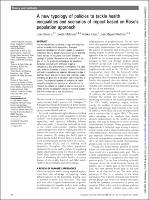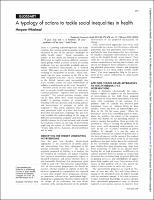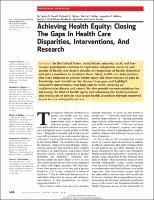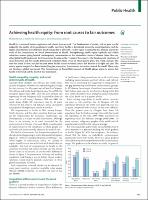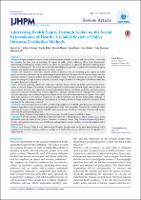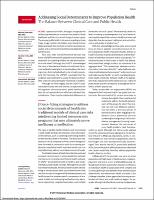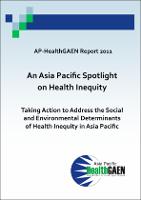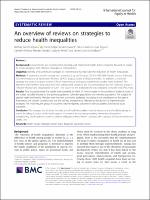Browsing by Title
Now showing items 3-22 of 299
-
A new typology of policies to tackle health inequalities and scenarios of impact based on Rose's population approach
(Journal of Epidemiology and Community Health, 2013)
The last decade has witnessed a surge in interest for policies to tackle health inequalities. Adequate theoretical development of policy models is needed to understand how to design and evaluate equity-oriented health policies. In this paper we review Graham’s typology of policies (focused on the worst-off, on the gap, or on the gradient) and propose an adaptation (targeted, universal with additional targeting, redistributive, and proportionate universalism). For each type, potential scenarios of impact on population health and health inequalities ... -
A Practical Vision of a More Equal Society
(2015)
Toward a New Radical Reformism Anthony Atkinson occupies a unique place among economists. During the past half-century, in defiance of prevailing trends, he managed to place the question of inequality at the center of his work while demonstrating that economics is first and foremost a social and moral science. In his new book, Inequality: What Can Be Done?—more personal than his previous ones and wholly focused on a plan of action—he provides us with the broad outlines of a new radical reformism. -
A Practitioner’s Guide for Advancing Health Equity: Community Strategies for Preventing Chronic Disease
(2013)
The intention of A practitioner’s guide for advancing health equity is to help practitioners and leaders incorporate a health equity view in their collaborations with community organizations. It offers ideas — with stories to illustrate — for how public health organizations can develop competency in the important work of building organizational capacity, engaging communities, developing partnerships and coalitions, and making the case for health equity. Each of the four sections of the Practitioner’s guide (1. foundational skills, 2. tobacco-free ... -
A Socioeconomic Disaggregation of the World Bank Human Capital Index
(World Bank, Washington, DC, 2019-09)
This paper documents inequality in health and education outcomes by constructing an index of human capital disaggregated by quintiles of socioeconomic status (SES) for a sample 51 mostly low- and middle-income countries. The index measures the expected future human capital of children born today, following the methodology of the World Bank Human Capital Index that was launched in October 2018. Within-country disparities in human capital outcomes across SES quintiles are large, accounting for roughly one-third of the total variation. On average, ... -
A typology of actions to tackle social inequalities in health
(Journal of Epidemiology & Community Health, 2007) -
Access to civil justice as a social determinant of health: a legal epidemiological cross-sectional study
(2024-06-14)
Background: Although it is widely acknowledged that access to civil justice (ATJ) is a key social determinant of health (SDOH), the existing literature lacks empirical evidence supporting ATJ as a SDOH for specific dimensions of health. Methods: A legal epidemiological, cross-sectional, postal survey was conducted on n = 908 randomly sampled participants in Hong Kong in March 2023. Data collected were perceptions of the civil justice system, health, and sociodemographics. Perceived ATJ was assessed using a modified version of the Inaccessibility ... -
Access to Covid-19 Vaccines and Concerns of Returnee Migrant Workers in Lao PDR During the Covid-19 Pandemic
(2022-07)
In Lao PDR (Lao People’s Democratic Republic), out-migration, often to neighbouring Thailand, is an important livelihood pathway for workers. The Covid-19 pandemic, however, had a significant impact on these international migrant workers. As the pandemic evolved, and lockdowns and travel restrictions were implemented, thousands of the estimated 1.3 million Lao nationals living abroad, mostly in Thailand, found themselves unemployed and started returning to Lao PDR. Many of these returning migrants were infected or had been exposed to the Covid-19 ... -
Access to Healthcare and Social Protection among Migrant Workers in Thailand before and during COVID-19 Era: A Qualitative Study
(2022-03-06)
Thailand is a popular host nation for international migrant workers, particularly those from Cambodia, Lao PDR, and Myanmar. Thailand has introduced approaches to protect their rights for health and social welfare, using various mechanisms over many years. However, the implementation of these policies is dynamic and has been influenced by national security, economic necessity, and public health concerns. The aim of this study was to explore how Thailand designs and implements health and social welfare policies for migrants in Thailand, both before ... -
Achieving equity within universal health coverage: a narrative review of progress and resources for measuring success
(2014)
Introduction: Equity should be implicit within universal health coverage (UHC) however, emerging evidence is showing that without adequate focus on measurement of equity, vulnerable populations may continue to receive inadequate or inferior health care. This study undertakes a narrative review which aims to: (i) elucidate how equity is contextualised and measured within UHC, and (ii) describe tools, resources and lessons which will assist decision makers to plan and implement UHC programmes which ensure equity for all. Methods: A narrative review ... -
Achieving Health Equity: Closing The Gaps In Health Care Disparities, Interventions, And Research
(2016)
In the United States, racial/ethnic minority, rural, and lowincome populations continue to experience suboptimal access to and quality of health care despite decades of recognition of health disparities and policy mandates to eliminate them. Many health care interventions that were designed to achieve health equity fall short because of gaps in knowledge and translation. We discuss these gaps and highlight innovative interventions that help address them, focusing on cardiovascular disease and cancer. We also provide recommendations for advancing ... -
Achieving health equity: from root causes to fair outcomes
(The Lancet, 2007) -
Achieving the targets for universal health coverage: how is Thailand monitoring progress?
(2019-04)
Universal health coverage (UHC) is one of the targets within the Sustainable Development Goalsthat the Member States of the United Nations have pledged to achieve by 2030. Target 3.8 has twomonitoring indicators: 3.8.1 for coverage of essential health services, for which a compound index from16 tracer indicators has recently been developed; and 3.8.2 for catastrophic expenditure on health.The global baseline monitoring of these two indicators in 2017 shows that the progress in many lowandmiddle-income countries is unlikely to be on track and ... -
Addressing Health Equity Through Action on the Social Determinants of Health: A Global Review of Policy Outcome Evaluation Methods
(Kerman University of Medical Sciences, 2018-02-06)
Background: Epidemiological evidence on the social determinants of health inequity is well-advanced, but considerably less attention has been given to evaluating the impact of public policies addressing those social determinants. Methodological challenges to produce evidence on policy outcomes present a significant barrier to mobilising policy actions for health equities. This review aims to examine methodological approaches to policy evaluation of health equity outcomes and identify promising approaches for future research. Methods: We conducted ... -
All-cause excess mortality among end-stage renal disease (ESRD) patients during the COVID-19 pandemic in Thailand: a cross-sectional study from a national-level claims database
(2024-01-25)
Objectives: COVID-19 infection increased nephrology-related risks and mortality rate among end-stage renal disease (ESRD) patients. The pandemic also disrupted essential healthcare services. We aim to explore all-cause excess mortality among ESRD patients who were members of the Universal Coverage Scheme (UCS), the largest public health insurance scheme in Thailand covering citizens who are not employed in the formal sector, including children and older persons. Design: A cross-sectional study. Setting We retrieved the dataset from the UCS ... -
An Asia Pacific Spotlight on Health Inequity: Taking Action to Address the Social and Environmental Determinants of Health Equity in Asia Pacific
(2011)
In the full report we describe the extent of health inequities between and within countries across the Asia Pacific region. We explore the plausible causal relationships between social and environmental factors and health inequities and describe actions that are taking place to improve health inequities in Asia Pacific. The report is based on pre-existing data policy-mapping case studies and expert knowledge from across the region. We have drawn upon reports and peer-reviewed publications from a diversity of disciplines such as public health ... -
An evolving Asean: vision and reality
(Asian Development Bank, 2019-09)
This volume is a compilation of the papers presented at the High-Level Workshop on the Evolving Nature of ASEAN’s Economic Cooperation: Original Vision and Current Practice, containing the authors’ personal reflections on ASEAN’s journey toward economic integration. The papers review the historical evolution of ASEAN’s economic agenda, capture its achievements, examine the challenges that have surfaced in the last decade, and recommend a way forward. The papers in this volume emphasize that, while there have been notable successes, the remaining ... -
An Evolving ASEAN: Vision and Reality
(Asian Development Bank, 2019)
The formation of ASEAN in 1967 was originally driven by political and security concerns. In the decades that followed, ASEAN’s scope evolved to include an ambitious and progressive economic agenda. In December 2015, the ASEAN Economic Community (AEC) was formally launched. Although AEC has enjoyed some notable successes, its vision of economic integration has yet to be fully realized. The publication reviews the evolution of ASEAN economic integration and assesses the major achievements. It also examines the challenges that have emerged during ... -
An overview of reviews on strategies to reduce health inequalities
(2020-12)
Background: Governments are incentivized to develop and implement health action programs focused on equity to ensure progress with effective strategies or interventions. Objective: Identify and synthesize strategies or interventions that facilitate the reduction of health inequalities. Methods: A systematic search strategy was carried out up until August 2019 in MEDLINE (Ovid), Embase (Elsevier), Cochrane Database of Systematic Reviews, LILACS, Scopus, Scielo and Epistemonikos. In addition, a snowball strategy was used. Literature reviews (LRs) ...

